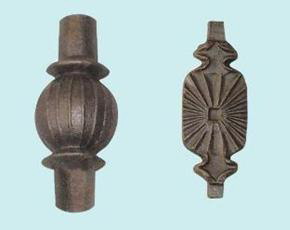| |
The Difference of Wrought Iron and Cast Iron
The simplest way to remember the
difference is to know that wrought iron is metal that has been
heated and then worked with tools to produce its shape and form,
while cast iron has been melted and poured into a mold to give it
the desired look.
Of course there is much more to it than simply melting the metal and
shaping it. Various chemical agents that are added and removed
affect the strength of the end product. Historically, wrought iron
had more of the metal impurities removed to make it easier to work
with, and to get a stronger end product.
However, in our modern era, metal
“purity” is no longer necessarily a quality of wrought iron. The
term is applied to any metal that has been worked with tools and
purity and durability of mass-produced products are not guaranteed.

Wrought Iron Parts
Cast iron is less pure as far as the
metal properties are concerned, but because the metal is poured into
precision-made molds, you receive a more accurate end-product. Even
though it is more brittle, it gained great popularity in the United
States in the nineteenth century because of its suitability to the
lower-cost mass production process in a time when wrought iron was
still an individual hand-craft. This is important for restoration
projects. It is more affordable and newer techniques, such as
ductile cast iron work, enable parts to be cast with larger sections
and with much greater strength.
Ductile cast iron was invented in 1943. Nodular graphite inclusions
make it less brittle than traditional cast iron. Its flexibility and
elasticity enable use in products where cast iron would not hold up.
Reliance Foundry offers bollards made from ductile cast iron as part
of their bollard product line. Decorative and architectural ductile
iron bollards enhance the outdoor space of a historical restoration,
while also offering perimeter definition and, if needed, bike
parking or chained area options.

Cast Iron Parts
Home |
More Articles |
|
